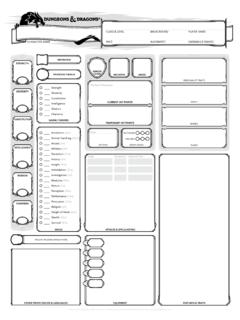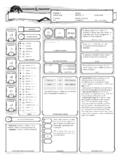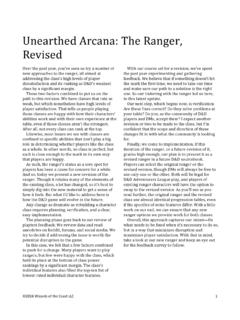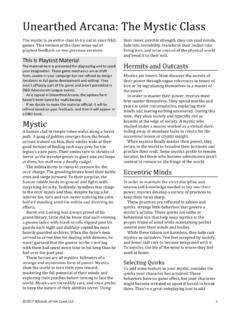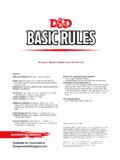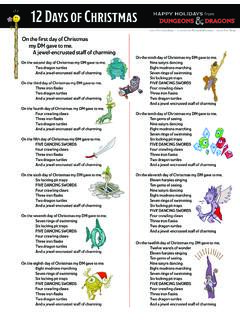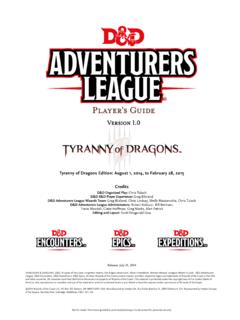Transcription of Sage Advice Compendium - Jeremy Crawford
1 Version @2017 Wizards of the Coast LLC. Permission granted to print and photocopy this document for personal use only. Page 1 Sage Advice CompendiumThe Sage Advice Compendium collects questions and an-swers about the rules of Dungeons & Dragons (fifth edi-tion). These are the official rulings of Jeremy Crawford , the game s lead rules developer. The document s version number changes when substan-tive additions or revisions have been to made to the text. The newest material appears in a shaded box like this ReferencesThe fifth edition of D&D has three official rulebooks, each of which was first published in 2014: Player s Handbook (abbreviated PH) Monster Manual (abbreviated MM) Dungeon Master s Guide (abbreviated DMG)The free Basic Rules contains portions of those three books and can be downloaded here: Play in the Adventurers League is also governed by the Adventurers League Player s have been issued for the early printings of certain fifth edition books and can be downloaded at the fol-lowing locations.
2 A corrected version of any of these books includes one of the following lines on its credits page:This printing includes corrections to the first printing includes s Handbook (2014) Manual (2014) Master s Guide (2014) of the Dragon Queen (2014) of the Apocalypse (2015) of the Abyss (2015) Coast Adventurer s Guide (2015) s Guide to Monsters (2016) RulingsOfficial rulings on how to interpret rules are made here in the Sage Advice Compendium . The public statements of the D&D team, or anyone else at Wizards of the Coast, are not official rulings; they are Advice . One excep-tion: the game s lead rules developer, Jeremy Crawford (@JeremyECrawford on Twitter), can make official rulings and does so in this document and on Twitter.
3 A Dungeon Master adjudicates the game and determines whether to use an official ruling in AnswersSage Advice answers that are relevant to the current state of the rules are compiled here. The Role of RulesWhy even have a column like Sage Advice when a DM can just make a ruling? Rules are a big part of what makes D&D a game, rather than simply improvised storytelling. The game s rules are meant to help organize, and even in-spire, the action of a D&D campaign. The rules are a tool, and we want our tools to be as effective as possible. No matter how good those tools might be, they need a group of players to bring them to life and a DM to guide their use. The DM is key.
4 Many unexpected things can happen in a D&D campaign, and no set of rules could reasonably ac-count for every contingency. If the rules tried to do so, the game would become unplayable. An alternative would be for the rules to severely limit what characters can do, which would be counter to the open-endedness of D&D. The direc-tion we chose for the current edition was to lay a foundation of rules that a DM could build on, and we embraced the DM s role as the bridge between the things the rules ad-dress and the things they don t. In a typical D&D session, a DM makes numerous rules decisions some barely noticeable and others quite obvi-ous. Players also interpret the rules, and the whole group keeps the game running.
5 There are times, though, when the design intent of a rule isn t clear or when one rule seems to contradict another. Dealing with those situations is where Sage Advice comes in. This column doesn t replace a DM s adjudication. Just as the rules do, the column is meant to give DMs, as well as players, tools for tuning the game according to their tastes. The column should also reveal some perspectives that help you see parts of the game in a new light and that aid you in fine-tuning your D&D experience. When I answer rules questions, I often come at them from one to three different perspectives. R AW. Rules as written that s what RAW stands for. When I dwell on the RAW interpretation of a rule, I m studying what the text says in context, without regard to the designers intent.
6 The text is forced to stand on its own. Whenever I consider a rule, I start with this perspective; it s important for me to see what you see, not what I wished we d published or thought we d published. RAI. Some of you are especially interested in knowing the intent behind a rule. That s where RAI comes in: rules as intended. This approach is all about what the designers Version @2017 Wizards of the Coast LLC. Permission granted to print and photocopy this document for personal use only. Page 2to determine AC, yet AC calculations generate questions frequently. That fact isn t too surprising, given the number of ways the game gives you to change your AC! Here are some ways to calculate your base AC:Unarmored: 10 + your Dexterity : Use the AC entry for the armor you re wearing (see PH, 145).
7 For example, in leather armor, you calcu-late your AC as 11 + your Dexterity modifier, and in chain mail, your AC is simply Defense (Barbarian): 10 + your Dexterity modifier + your Constitution Defense (Monk): 10 + your Dexterity modifier + your Wisdom Resilience (Sorcerer): 13 + your Dexter-ity Armor: 10 + your Dexterity modifier + your natural armor bonus. This is a calculation method typically used only by monsters and NPCs, although it is also relevant to a druid or another character who assumes a form that has natural methods along with any others that give you a for-mula for calculating your AC are mutually exclusive; you can benefit from only one at a time.
8 If you have access to more than one, you pick which one to use. For example, if you re a sorcerer/monk, you can use either Unarmored De-fense or Draconic Resilience, not both. Similarly, a druid/barbarian who transforms into a beast form that has natu-ral armor can use either the beast s natural armor or Unar-mored Defense (you aren t considered to be wearing armor when you use natural armor). What about a shield? A shield increases your AC by 2 while you use it. For example, if you re unarmored and use a shield, your AC is 12 + your Dexterity modifier. Keep in mind that some AC calculations, such as a monk s Unar-mored Defense, prohibit the use of a shield. Once you have your base AC, it can be temporarily mod-ified by situational bonuses and penalties.
9 For instance, having half cover gives you a +2 bonus to your AC, and three-quarters cover gives a +5 bonus. Spells sometimes modify AC as well. Shield of faith, for example, grants a tar-get a +2 bonus to AC until the spell ends. Magic items can also enhance your AC. Here are a few examples: +1 chain mail gives you an AC of 17, a ring of protection gives you a +1 bonus to AC no matter what you re wearing, and bracers of defense grant you a +2 bonus to AC if you re not wearing armor or using a TraitsDoes the Trance trait allow an elf to finish a long rest in 4 hours? If an elf meditates during a long rest (as described in the Trance trait), the elf finishes the rest after only 4 hours.
10 A meditating elf otherwise follows all the rules for a long rest; only the duration is changed. [This answer has been altered as a result of a tweak to the rules for a long rest, which appears in newer printings of the Player s Handbook.]Do the lightfoot halfling and wood elf hiding racial traits allow them to hide while observed? The lightfoot halfling and wood elf traits Naturally Stealthy and Mask of the Wild do allow members of those subraces to try to hide in their special circumstances even when observers are nearby. Normally, you can t hide from someone if you re meant when they wrote something. In a perfect world, RAW and RAI align perfectly, but sometimes the words on the page don t succeed at communicating the designers intent.
